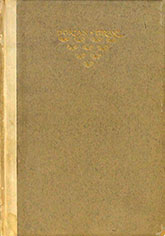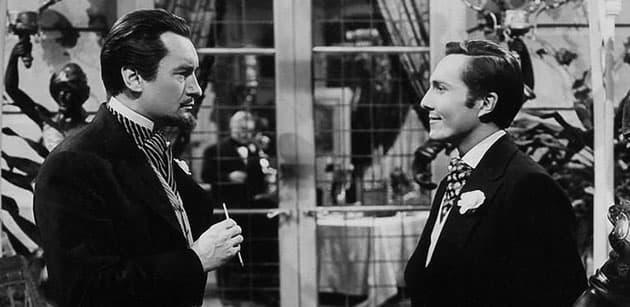The Picture of Dorian Gray
Critique • Quotes • At the movies
1945, 2009
 First edition
First editionFirst publication
1890, novella in Lippincott's Monthly Magazine
First book publication
1891
Literature form
Novel
Genres
Literary, fantasy, horror, philosophical fiction
Writing language
English
Author's country
Ireland
Length
Approx. 78,500 words

George Sanders as Lord Henry Wotton, left, influences Hud Hatfield's Dorian Gray.
Save our movie-enchanted souls
The Picture of Dorian Gray (1945): Film, 110 minutes; director/writer Albert Lewin; featuring George Sanders, Hud Hatfield, Angela Lansbury, Donna Reed
Over thirty adaptations of Oscar Wilde's The Picture of Dorian Gray have made it to the screen, starting in the earliest days of moving pictures—which seems appropriate somehow.
Some of these adaptations treat the tale as a horror story, some as a literate drawing room comedy, some as soft-core pornography. But one thing is common to them all. Well, two things really. They all depart from the original plot in some way. And none of them seem to make much money.
There's something about this novel that makes it an enduringly appealing story for readers and movie-makers, but warns away movie-goers. Maybe the public gets a feeling the story is against the superficial kind of hedonism represented by Hollywood and movies themselves. Maybe we fear losing our own souls in those enticing images.
Or maybe it's just too clever by half. And we know the cautionary tale so well already that we don't need to sit through another telling of it.
Which is not to say there aren't some great versions of it out there, which we could benefit from.
Despicable him
Put this one in the literate category, with a side order of horror.
George Sanders is the silver-tongued Lord Henry Wotton, whose clever words turns the naïve Dorian Gray onto the path of self-indulgence and ultimately evil in the 1945 film, The Picture of Dorian Gray.
This Hollywood production may be at first a disappointment, because one expects Sanders, a huge star, to take on the central role. But it turns out to be a good casting move. The British actor's silky screen presence and his upper-class diction are perfect for the jaded aristocrat spouting the humorous Oscar Wilde aphorisms without seeming to force it. (Except for that funny little goatee that screams "evil! evil!")
However, this leaves the Dorian Gray role to be essayed by a rather bland American actor, one Hud Hatfield. It makes a certain amount of sense to have Dorian at first presented as a clean slate upon which Lord Henry or high society or the devil, whatever, can work their wicked ends. But Dorian is also supposed to be a startlingly attractive young man who exudes a kind of nobility, a new ideal of humanity that inspires the artist Basil Hallward. And we're supposed to get an idea of the transformation, his unease, his paranoia, that goes on beneath his beautiful exterior as he ages, or rather as he doesn't age. None of which I sense. We never really care for him at all—not in his early innocent days, nor during his decline, nor when he briefly attempts a moral rally just before the end.
The original theatrical trailer for 1945 film of The Picture of Dorian Gray.
Some reviews of this film see Hatfield's acting as chilling and disturbing—presumably providing the "horror" aspect—as he goes about his debauchery (most of which we don't witness). But this is imputing something to his blank stares that isn't there in a dull, unmoving performance.
A silly bit that's added is to have Dorian make his original wish in the presence of an Egyptian cat statue, whose magical powers presumably give him what he desires in return for his soul. Part of Wilde's poem "The Sphinx" is actually recited.
We don't really get to see his nasty decline for ourselves in the years after the death of his love, Sibyl Vane. His despicable behaviour is described by others, including by voice-over narrator Cecil Hardwicke in an uncredited performance.
Sibyl, by the way, as played by a pretty, young Angela Lansbury, is a singer, rather than an actor as in the book. And her suicide is a consequence of a letter and cash Dorian sends her to end their engagement. The whole theatrical subplot is excised. Though the doomed revenge attempt of Sibyl's brother is included.
Another subplot is also revised a little, as Dorian takes up with Gladys Hallward (Donna Reed, who get higher billing than Lansbury). She's the niece of Basil Hallward whom he has killed by then, taking the place in this script of Hetty Merton in the novel.
The familiar ending is retained, however.
This film was supposedly considered avant garde in its day, though this is hard to see today. The occasional use of a full-colour portrait, showing the stages in Dorian's degeneration, in the otherwise black-and-white film is an interesting effect however.
Some critics have also detected a certain sexual ambivalence in the film, especially in the attitude of Lord Henry toward Dorian, a stance that has some grounds in the novel. But again this is scarcely noticeable to today's viewers. For explicit sexual references we have to go to the 2009 film.
— Eric
Critique • Quotes • At the movies
1945, 2009

